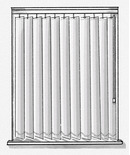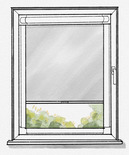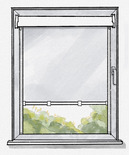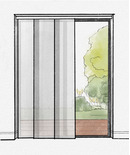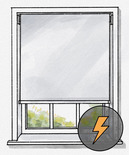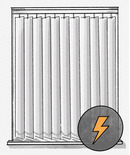Fire Retardant Blinds
If you are looking for safety and style together, fire retardant blinds are a perfect choice for you. We offer blinds featuring fabrics with a flame retardant coating to protect your beloved home from any danger and provide an extra element of safety for your family.
Fire retardant blinds are essential by law in commercial, public and educational spaces and also ideal for the home. All our flame-resistant fabrics have British standard certification that satisfies requirements for blinds in commercial, public and educational environments.
Our blinds are made from top-quality fabrics FR fabrics and are trusted by many happy residential and commercial customers.
Browse our collection of blinds and fabrics below. Order free samples of your favourite colours and patterns. Get an instant quote and order online with speedy delivery!
Filter Our Products
DARKTEX FR BLACKOUT
Darktex FR is an extra-wide blackout fabric which is availabe in a fantastic range of colours. Its 3 metre roll-width makes it ideal for extra-large windows such as bi-fold doors. It is fire retardent and 100% Polyester.



DARKTEX FR BEIGE 3m 230v Radio Operated Electric Roller BlindsElectric Roller Blinds

DARKTEX FR BLACK 3m 230v Radio Operated Electric Roller BlindsElectric Roller Blinds

DARKTEX FR CREAM 3m 230v Radio Operated Electric Roller BlindsElectric Roller Blinds


DARKTEX FR DARK GREY 3m 230v Radio Operated Electric Roller BlindsElectric Roller Blinds

DARKTEX FR LIGHT GREY 3m 230v Radio Operated Electric Roller BlindsElectric Roller Blinds

DARKTEX FR WHITE 3m 230v Radio Operated Electric Roller BlindsElectric Roller Blinds

DARKTEX FR BEIGE 3m Battery Powered Roller BlindsBattery Powered Roller Blinds, Electric Roller Blinds


DARKTEX FR BLACK 3m Battery Powered Roller BlindsBattery Powered Roller Blinds, Electric Roller Blinds

DARKTEX FR CREAM 3m Battery Powered Roller BlindsBattery Powered Roller Blinds, Electric Roller Blinds

DARKTEX FR DARK GREY 3m Battery Powered Roller BlindsBattery Powered Roller Blinds, Electric Roller Blinds

DARKTEX FR LIGHT GREY 3m Battery Powered Roller BlindsBattery Powered Roller Blinds, Electric Roller Blinds


DARKTEX FR WHITE 3m Battery Powered Roller BlindsBattery Powered Roller Blinds, Electric Roller Blinds

DARKTEX FR BEIGE 3m 230v Relay Operated Electric Roller BlindsElectric Roller Blinds

DARKTEX FR BLACK 3m 230v Relay Operated Electric Roller BlindsElectric Roller Blinds

DARKTEX FR CREAM 3m 230v Relay Operated Electric Roller BlindsElectric Roller Blinds

Frequently Asked Questions about Fire Retardant Blinds
Do blinds need to be fire retardant?
To meet British Standards BS 5867, all blinds and curtains used in public spaces must be made from fire-resistant materials or, alternatively, must be chemically treated to make them fire-retardant.
Are blinds a fire hazard?
Blinds in themselves are not a fire hazard. However, fabrics used in soft furnishings such as blinds and curtains, that are not FR-rated may ignite in a scenario where they are exposed to naked flames, and therefore may allow a fire to spread. It is therefore important in environments where there may be a risk of fire, such as kitchens, to consider selecting blind fabrics which are fire retardant.
Are there any special requirements relating to fire safety for curtains?
When purchasing fire-resistant curtains, you must confirm that they have the appropriate certification, BS5867. A fabric and curtain maker will provide fire retardant certificates for the material indicating that the face fabric and lining have passed the test.
Are window blinds flammable?
The flammability of window blinds will depend on several factors. Is the material that the blind is made of inherently fire retardant or treated with a fire retardant coating? If not, then a window blind fabric should be considered flammable. The degree of flammability will depend on the material type with fabrics made from natural fibres igniting more easily.
What materials do not catch on fire?
Most synthetic fabrics, such as nylon, acrylic or polyester resist ignition do not catch on fire. Such fabrics tend to melt instead of igniting. In particular, polyester and nylon have high melting temperatures and have therefore become commonly used.
How long does fire retardant last on curtains?
Inherently flame retardant fabrics are less likely to lose their flame retardancy over time and due to laundering, in comparison to fabrics that have been treated with a flame retardant coating. There are two levels of flame retardancy under British Standard BS5867 - Part 2b and Part 2c. Both certify that the fabric being tested can be washed regularly without losing its flame retardancy. Part 2c is the more stringent standard and under the British Standard is tested after being laundering 50 times at 40 degrees centigrade. Part 2b requires 12 wash cycles at 40 degrees centigrade.
Is there a difference between flame retardant and fire retardant?
Whilst the terms flame retardant and fire retardant are often used interchangeably, the flame retardant is actually the correct phrase to be associated with the chemical treatment of fabrics and other materials in order to prevent or slow the further development of ignition when the material comes into contact with a source of ignition such as a flame.
By contrast, fire retardant relates to using substances to reduce the flammability, specifically of organic materials which may include fabrics, but also materials found in buildings and wildlife.
How do I know if my curtains are fire retardant?
Fabrics and decorations that have been treated with fire retardants should always have a tag attached to them that specifies when the item was treated, with the permitted product, and whether or not it has to be re-treated.
What chemicals are used in fire retardants?
Fire retardants may contain chlorine, phosphorus, nitrogen, metals, boron or bromine. The most common type of fire retardant is brominated, meaning it contains bromine. Brominated fire retardants are often used in treating appliances, electronics, furniture, construction materials and fabrics.
What are fire retardant blinds and in which situations can they be used?
Fire retardant blinds are a legal requirement in commercial, public and educational spaces and also ideal for the home environment. They use a specially treated fabric to slow down the spread of fire. Besides being fire resistant, they are equally stylish, functional, and come in a range of sizes and colours to suit any interior. They're a particularly wise choice if you're considering thermal blinds for French doors. They not only reduce the risk of fires, but also improve heat insulation, making them ideal for large glass expanses.









